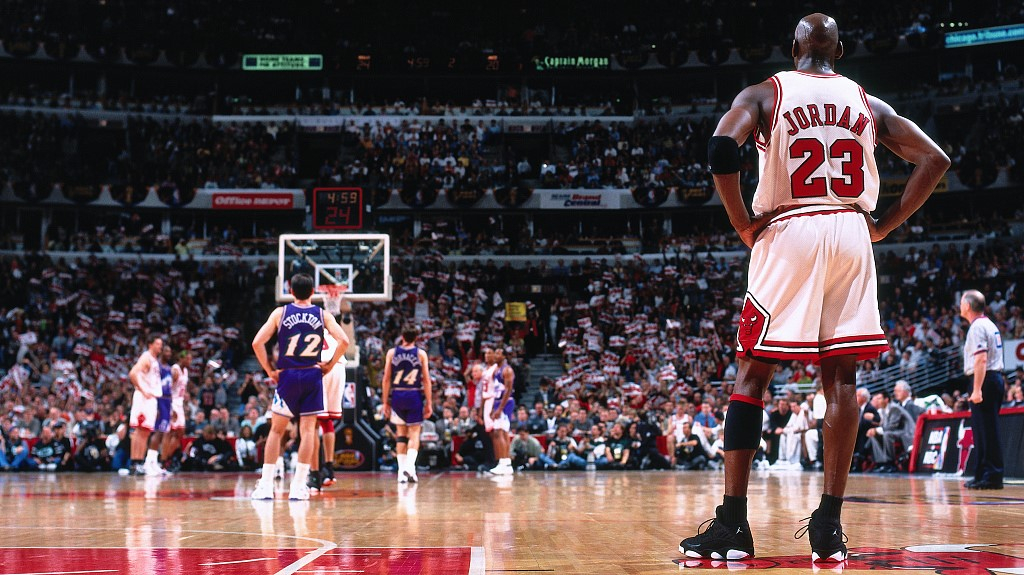
Michael Jordan #23 of the Chicago Bulls stands on the court in Game 5 of the NBA Finals against the Utah Jazz at the United Center in Chicago, Illinois, June 12, 1998. /VCG
Michael Jordan #23 of the Chicago Bulls stands on the court in Game 5 of the NBA Finals against the Utah Jazz at the United Center in Chicago, Illinois, June 12, 1998. /VCG
ESPN's Michael Jordan documentary "The Last Dance" introduced a different side of the greatest player in NBA history to more people.
Despite Larry Bird's well-known comment "It's just God disguised as Michael Jordan" about the Bulls No. 23 after the 63-point playoff game in 1986, Jordan's success should not be taken for granted. He went through more than you could imagine to become what he is today.
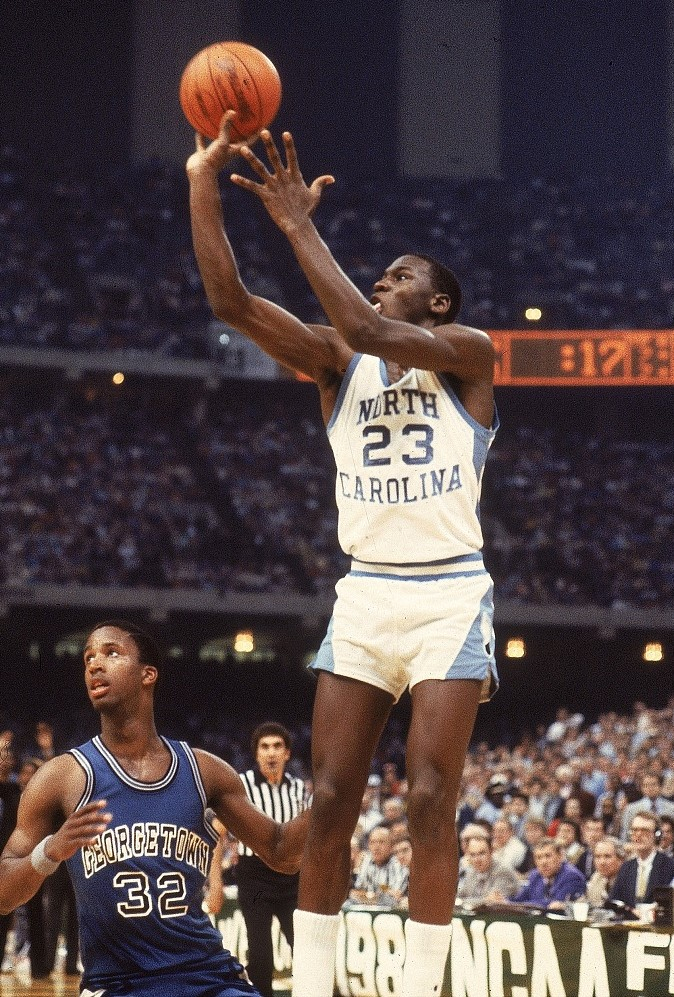
Michael Jordan #23 of North Carolina Tar Heels makes the game-wiining shot in the NCAA Final against Georgetown at the Louisiana Superdome in New Orleans, Louisiana, March 29, 1982. /VCG
Michael Jordan #23 of North Carolina Tar Heels makes the game-wiining shot in the NCAA Final against Georgetown at the Louisiana Superdome in New Orleans, Louisiana, March 29, 1982. /VCG
In 1982, freshman Jordan beat the buzzer to help North Carolina (Chapel Hill) defeat Georgetown in the NCAA Final, but scout reports said he could penetrate with his left hand and he's not a reliable jump shooter.
In 1984, he led the U.S. national team to win the Olympic gold medal in Los Angeles and won almost all major college basketball awards himself. However, Hakeem Olajuwon and Sam Bowie were still selected before him in the NBA Draft.
In his rookie season, Jordan scored the league's highest 2,313 points and averaged 28.2 points, 6.5 rebounds, 5.9 assists and 2.4 steals per game at a field goal rate of 51.5 percent. Nonetheless, he was only named the All-NBA Second Team because the two guards in the First Team were Magic Johnson (18.3 points, 6.2 rebounds, 12.6 assists) and Isiah Thomas (21.2 points, 4.5 assists, 13.9 assists).
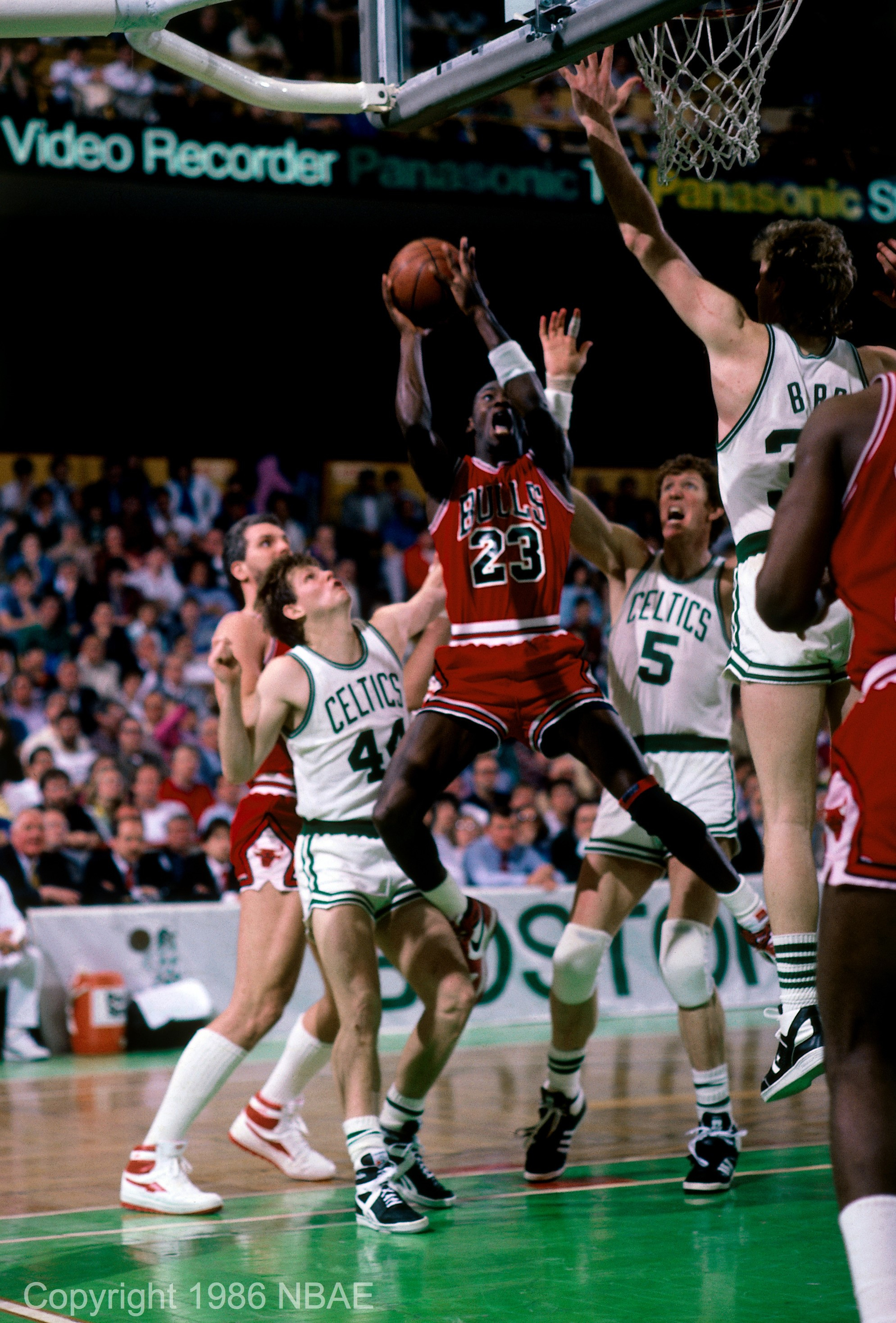
Michael Jordan #23 of the Chicago Bulls shoots the ball in Game 2 of the NBA playoffs against the Boston Celtics at the Boston Garden in Boston, Massachusetts, April 20, 1986. /VCG
Michael Jordan #23 of the Chicago Bulls shoots the ball in Game 2 of the NBA playoffs against the Boston Celtics at the Boston Garden in Boston, Massachusetts, April 20, 1986. /VCG
Having played only 18 games in the 1985-86 regular season because of injury, Jordan shocked the whole league in the playoff series against the Boston Celtics, but the Bulls were swept by the Celtics 3-0.
In his third year, Jordan scored 37.1 points per game and began to reap NBA scoring championships, people said he was not a good defender.
In 1988, he was the NBA Most Valuable Player, Defensive Player of the Year, scoring champion and steal leader. However, people said he only had individual performance but, unlike Bird and Johnson, could not help his team win.
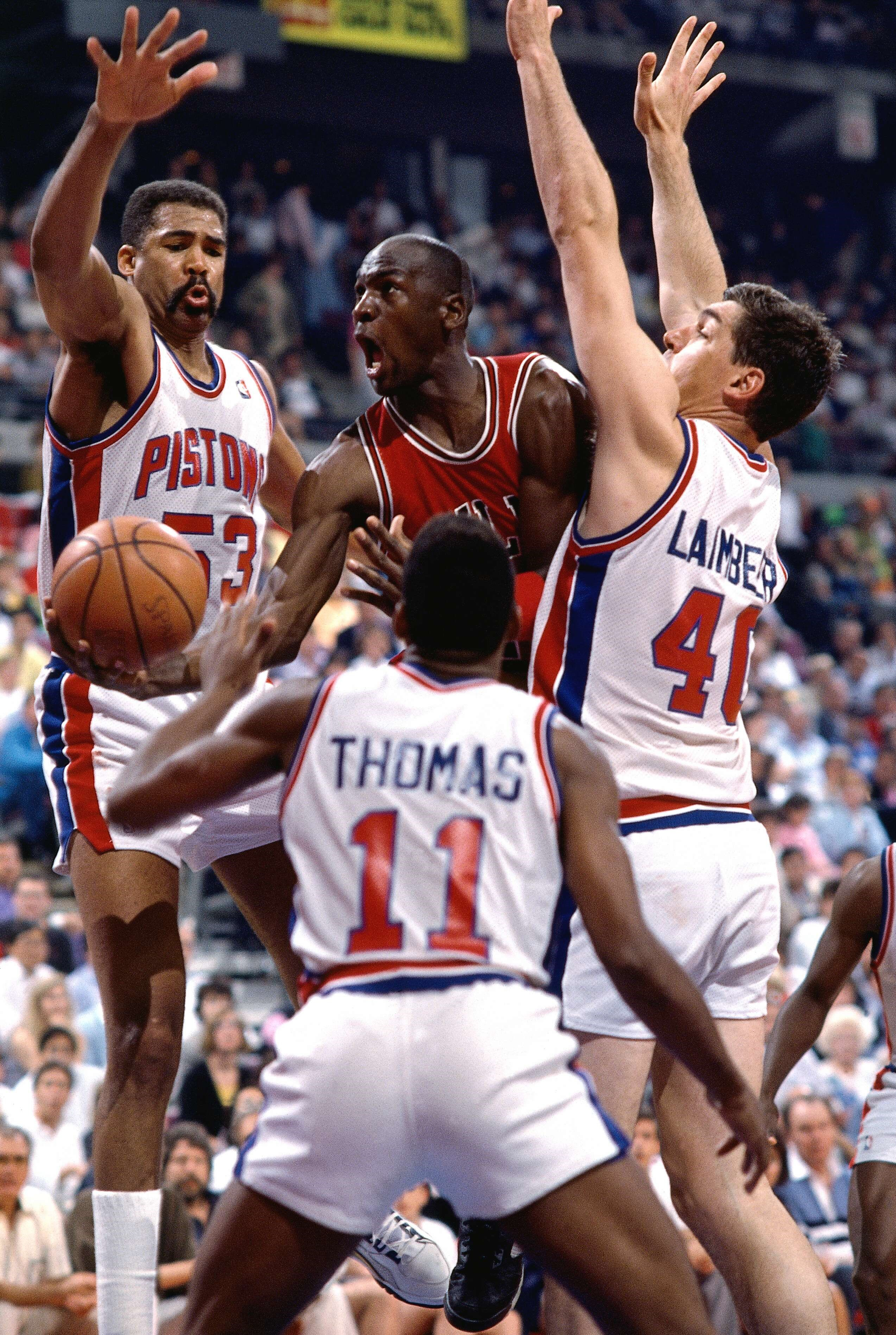
Michael Jordan (C) of the Chicago Bulls tries to shoot the ball under the defense of three players in the game against the Detroit Pistons at the The Palace of Auburn Hills in Detroit, Michigan, 1989. /VCG
Michael Jordan (C) of the Chicago Bulls tries to shoot the ball under the defense of three players in the game against the Detroit Pistons at the The Palace of Auburn Hills in Detroit, Michigan, 1989. /VCG
By the way, in the three seasons between 1988 and 1990, Jordan and the Bulls kept being knocked by the Detroit Pistons in the playoffs. Chuck Daly created "The Jordan Rules" which were carried out by "The Bad Boys" to torture him defensively.
In 1991, Jordan led Chicago to 61 wins, a 4-0 sweep of Detroit in the Eastern Conference Finals and beat the Los Angeles Lakers in the NBA Finals to win the first title in franchise history. However, Magic Johnson's teammate Mychal Thompson said players appreciated Johnson and Bird better.
In 1992, before the Finals, the press called Clyde Drexler of the Portland Trail Blazers a better 3-point shooter and a better teammate compared with Jordan. Then in Game 1, the Bulls' No. 23 buried six shots from downtown before making his famous shoulder-shrugging move.
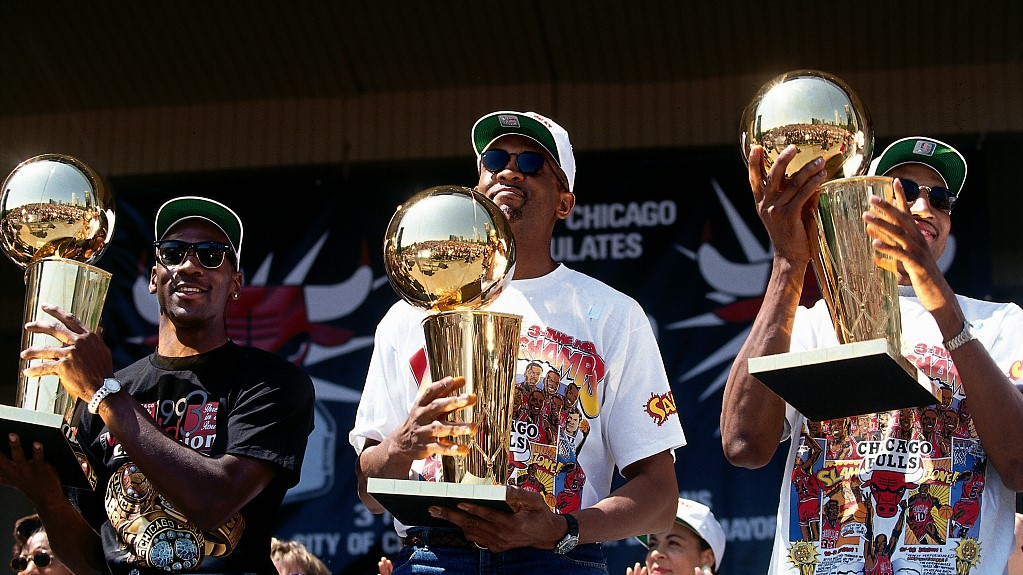
L-R: Michael Jordan, Bill Cartwright and Scottie Pippen of the Chicago Bulls celebrates with the three championship trophies during a rally in Chicago, June 26, 1993. /VCG
L-R: Michael Jordan, Bill Cartwright and Scottie Pippen of the Chicago Bulls celebrates with the three championship trophies during a rally in Chicago, June 26, 1993. /VCG
In 1993, Charles Barkley beat Jordan to win the regular season MVP and challenged him in the Finals. Jordan averaged 41 points, 8.5 rebounds and 6.3 assists in six games, the best Finals performance ever in league history, to seal his first three-consecutive-title record.
In 1995, Jordan came back from baseball but watched the Bulls knocked out by the young Orlando Magic in the playoffs. Nick Anderson mocked him: "No. 45 (Jordan's jersey number back then) doesn't explode like No. 23 used to."
In 1996, 33-year-old Jordan led a starting-lineup which was on average 32 years old to claim record 72 wins in the regular season and start a another three-straight-championship tour in the finals.
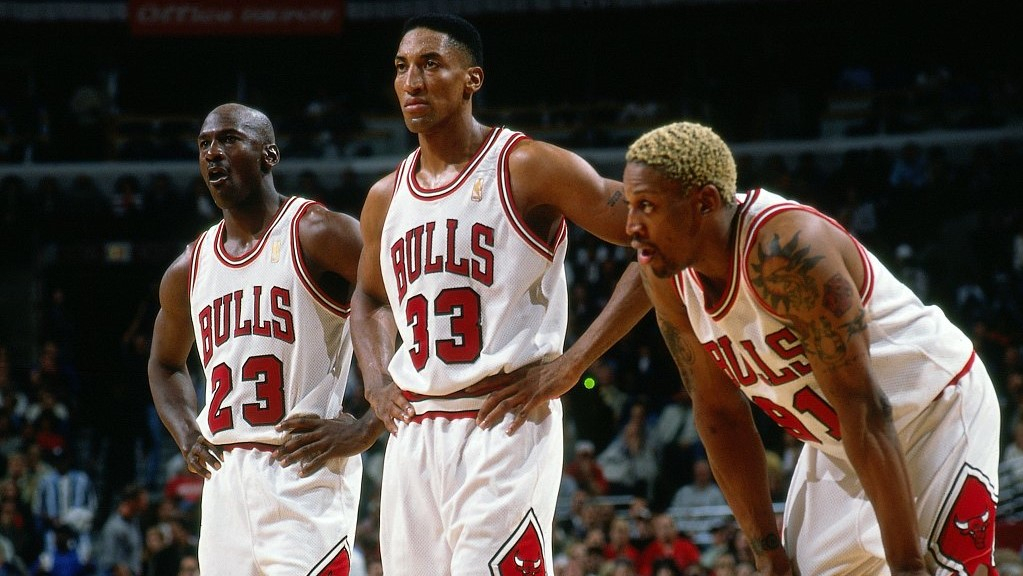
Michael Jordan #23, Scottie Pippen #33 and Dennis Rodman of the Chicago Bulls stand togehter in a game at the United Center in 1997. /VCG
Michael Jordan #23, Scottie Pippen #33 and Dennis Rodman of the Chicago Bulls stand togehter in a game at the United Center in 1997. /VCG
In 1997, Jordan made the game-winner to help the Bulls lead 1-0 in the Finals and then dragged his food-poisoned body to drop 38 points, seven rebounds, five assists and three steals in Game 5 to, again, help his team lead 3-2 in the series. This game was later known as the "Flu Game."
Then there was 1998, The Last Dance season. Before the season had started, Chicago's general manager Jerry Krause made it clear that their head coach Phil Jackson will leave after this season. Their second in command Scottie Pippen was tired of the team and determined to leave in summer. Besides, he missed 38 games because of back injury.
The Bulls were old, slow, lacked aggressiveness and had to rely on defense in most of the games. In fact, they were only 8-7 in the first month.
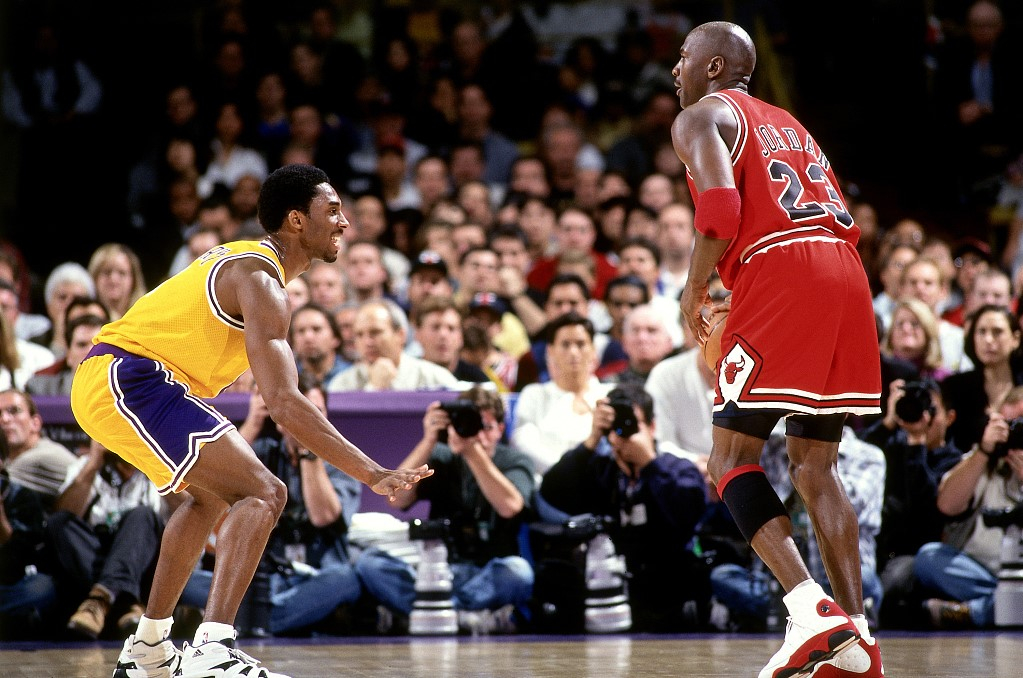
Michale Jordan #23 of the Chicago Bulls handles the ball, facing the defense of Kobe Bryant of the Los Angeles Lakers at the Forum in Inglewood, California, February 1, 1998. /VCG
Michale Jordan #23 of the Chicago Bulls handles the ball, facing the defense of Kobe Bryant of the Los Angeles Lakers at the Forum in Inglewood, California, February 1, 1998. /VCG
Nonetheless, the team finished the regular season 62-20. They only lost one game when they reached the Conference Finals. Then they defeated the Indiana Pacers 4-3 – in Game 7 the Bulls' FG rate as a team was only 38 percent.
So how did they do it?
Because they had Jordan, who scored a total 2,357 points in the regular season, averaging 28.7 points in 38.8 minutes per game and claimed 32.4 points in 41.5 minutes per game in the playoffs.
In the 1998 Finals, the Utah Jazz took Game 1 and then the Bulls achieved three wins in row. In Game 5, Jordan missed the buzzer-beater and watched the Jazz claim a comeback win.
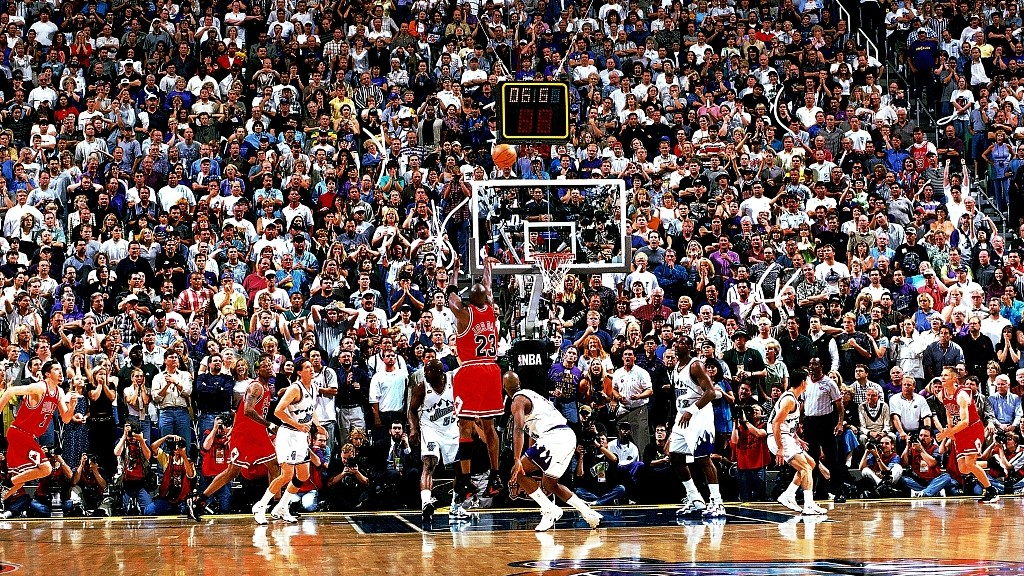
Michael Jordan #23 of the Chicago Bulls makes a game-winning shot in Game 6 of the NBA Finals against the Utah Jazz at the Delta Center in Salt Lake City, Utah, June 14, 1998. /VCG
Michael Jordan #23 of the Chicago Bulls makes a game-winning shot in Game 6 of the NBA Finals against the Utah Jazz at the Delta Center in Salt Lake City, Utah, June 14, 1998. /VCG
In Game 6, Pippen missed the second and third quarter because he had to rest his back in the locker room. Jordan scored 41 points, including 12 in the last quarter. There were 41.9 seconds left and Utah led 86-83.
Jordan had the ball, facing Bryon Russell in the right wing. He accelerated, broke through the defense of Russell and scored two points with a standard layup. 86-85, 37.1 seconds to go.
Jazz Ball. Karl Malone tussled with Dennis Rodman in the left to the paint, he received the ball but Jordan let go of Jeff Hornacek to double team Malone. Jordan got the ball and he drove to the left wing, looking at Russell. With 10 seconds to go, Jordan entered 3-point line, dodged Russell with a crossover. "Jordan, open, Chicago with the lead!" 87-86 before John Stockton missed the last 3-pointer.
That was the second three-straight-title tour and the sixth NBA championship of Michael Jordan.